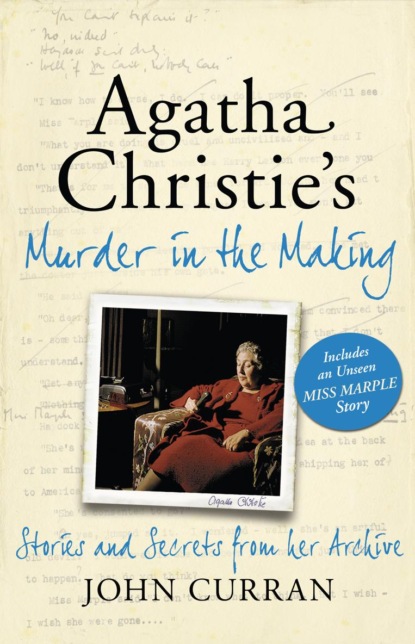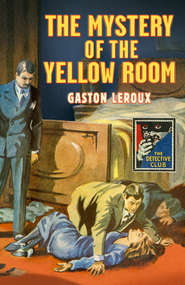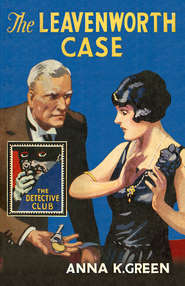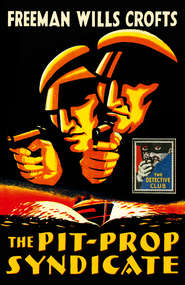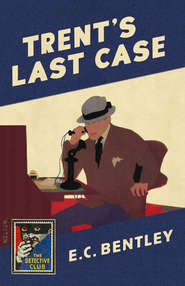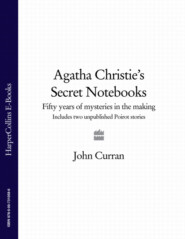По всем вопросам обращайтесь на: info@litportal.ru
(©) 2003-2024.
✖
Agatha Christie’s Murder in the Making: Stories and Secrets from Her Archive - includes an unseen Miss Marple Story
Настройки чтения
Размер шрифта
Высота строк
Поля
Handwriting and transcription
Before describing the handwriting in the Notebooks, it is only fair to emphasise that these were notes and jottings and there was no reason to make an effort to maintain a certain standard, as no one but Christie herself was ever intended to read them. These were personal journals and not written for any purpose other than to clarify her thoughts. For her first ten years of productivity and at her creative peak her handwriting is almost indecipherable. Whether in fountain pen, biro or pencil, it looks, in many cases, like shorthand and it is debatable whether even she could read some sections of it. I have no doubt that the reason for this near-illegibility was that, during these hugely prolific years, her fertile brain teemed with ideas for books and stories. It was a case of getting them on to paper as fast as possible, and clarity of presentation was a secondary consideration. Although in most cases it is safe to assert that as we get older our handwriting deteriorates, in the case of Agatha Christie the opposite is the case, so that by the early 1950s and, for example, 1953’s After the Funeral in Notebook 53, the notes could be read relatively easily.
Solely in the interests of legibility, when transcribing material from the Notebooks I have removed some capital letters, brackets and dashes and in some cases have separated a paragraph of words, broken only by dashes, into separate sentences. All remaining question marks, underlinings and dashes, as well as some grammatical errors, are reproduced as they appear in the Notebooks.
If I have omitted text from within extracts I indicate this by the use of dots.
Misspellings have not been corrected but marked as [sic].
Square brackets are used for editorial clarification or remarks.
Dates of publication of works by Christie refer to the UK edition. They have been taken, for the most part, from contemporary catalogues in Collins archives. Traditionally, Crime Club titles were published on the first Monday of the month and in the few instances where actual dates were not available, I have used this guideline. In general, publication dates are included only with the first mention of each title in the Decade introductions. They are not included with later references, unless the timescale is relevant.
At the beginning of each chapter I have included a list of titles whose solutions are revealed within. It proved impossible to discuss a title intelligently, or to compare it to the Notebooks, unless I disclosed some endings. And in many cases the notes mention the vital name or plot device anyway. Christie’s creative ruthlessness in deciding her killer is a vital part of her genius and to try circumventing this with ambiguous verbal gymnastics cannot do her justice.
Since the publication of Agatha Christie’s Secret Notebooks I have received many enquiries regarding access to the Notebooks. Although it is not possible for the public to read the Notebooks, two of them are on public display in Devon, England. One can be seen in Torquay Museum and a second in Paignton Library and Information Centre.
The quotations at the beginning of each chapter are from Agatha Christie’s Autobiography.
In Agatha Christie’s Secret Notebooks my aim was to examine how a unique body of work, produced over a 50-year period, came into being. I analysed the creative process of the Queen of Crime and showed how the chaotic scribbles in a copybook were transformed into a body of detective fiction that set the standard for the time and, as it transpired, for all time. A brief resumé at this point will aid an understanding of later chapters.
In February 1955, on the BBC radio programme Close-Up, Agatha Christie admitted, when asked about her process of working, that ‘the disappointing truth is that I haven’t much method’. But although she had no particular method, no definite system, we discover that the apparently indiscriminate jotting and plotting in the Notebooks is her method. This randomness is how she worked, how she created, how she wrote. She thrived mentally on chaos, it stimulated her more than neat order; rigidity stifled her creative process. She used the Notebooks as a combination of sounding board and literary sketchpad where she devised and developed; selected and rejected; sharpened and polished; revisited and recycled.
One system of creation that she used, especially during the prolific years, was the listing of a series of scenes, sketching what she wanted each to include and allocating to each individual scene a number or a letter. She would subsequently reorder those letters to suit the purposes of the plot in a pre-computer version of ‘cut and paste’.
She reused plot devices throughout her career; and she recycled short stories into novellas and novels – she often speculates in the Notebooks about the expansion or adaptation of an earlier title. The Notebooks demonstrate how, even if she discarded an idea for now, she left everything there to be considered again at a later stage. And when she did that, as she wrote in her Autobiography, ‘What it’s all about I can’t remember now; but it often stimulates me.’
Many of Christie’s best plots did not necessarily spring from a single devastating idea. She considered all possibilities when she plotted and did not confine herself to one idea, no matter how good it may have seemed. She rattled off possibilities and variations on the basic idea so that, for instance, in very few cases is the identity of the murderer settled from the start of the plotting. An example from the notes for Mrs McGinty’s Dead, as she considers the possible identity both of the killer from the past and from the present, illustrates this:
1 A. False – elderly Cranes – with daughter (girl – Evelyn) B. Real – Robin – son with mother son
2 A. False Invalid mother (or not invalid) and son B. Real – dull wife of snob A.P. (Carter) Dau[ghter]
3 A. False artistic woman with son B. Real middle-aged wife – dull couple – or flashy Carters (daughter invalid)
4 A. False widow – soon to marry rich man
5 [A] False man with dogs – stepson – different name [B] Real – invalid mother and daughter – dau[ghter] does it
Throughout the Notebooks murder methods, motives, settings and even the detective are apt to change between the early notes and the published book; names, in particular, change, sometimes radically. I try, where possible, to identify which character Christie may have had in mind when this occurs.
In Agatha Christie’s Secret Notebooks I examined over 25 novels, almost a dozen short stories and the genesis of all 13 of The Labours of Hercules; I also included some stage scripts and presented two ‘new’ Hercule Poirot investigations. Agatha Christie’s Murder in the Making includes the rest of her novels, as well as an ‘unknown’ stage script. And, unlike Agatha Christie’s Secret Notebooks, this new volume contains some more personal glimpses – her reading lists, her own account of the creation of Hercule Poirot, a fascinating letter to The Times. As well as a new version of a Miss Marple short story I also include, from either end of her career, the original denouement of The Mysterious Affair at Styles and her notes for a final, unwritten novel.
If any further proof were needed of the universal and timeless appeal of Agatha Christie, the appearance of Agatha Christie’s Secret Notebooks provided it. Since its appearance I have received correspondence from Christie devotees the world over: from Australia, Russia, Croatia, Brazil, Argentina and Italy as well as the UK, the USA and Ireland; I have been interviewed for magazines, radio and TV in France, Portugal, Turkey, the USA, Iceland, Finland, Spain and Brazil as well as the UK and Ireland; I have been invited to Tokyo, Helsinki, Istanbul and New York, and to literary festivals throughout the UK and Ireland. And the book itself has been translated into 17 languages including Vietnamese and Croatian.
As a certain Belgian might say, ‘It gives one furiously to think, does it not …?’
1
Rule of Three
‘One of the pleasures in writing detective stories is that there are so many types to choose from: the light-hearted thriller … the intricate detective story … and what I can only describe as the detective story that has a kind of passion behind it …’
SOLUTIONS REVEALED
The A.B.C. Murders • After the Funeral • Appointment with Death • The Body in the Library • Curtain • Death in the Clouds • Death on the Nile • Evil under the Sun • Endless Night • Hercule Poirot’s Christmas • The Hollow • Lord Edgware Dies • The Man in the Brown Suit; • ‘The Man in the Mist’ • ‘The Market Basing Mystery’ • The Mousetrap • The Murder at the Vicarage • ‘Murder in the Mews’ • The Murder of Roger Ackroyd • Murder on the Orient Express • The Mysterious Affair at Styles • One, Two, Buckle my Shoe • Ordeal by Innocence • A Pocket Full of Rye • Sparkling Cyanide • Taken at the Flood • They Came to Baghdad • They Do It with Mirrors • Three Act Tragedy • ‘The Unbreakable Alibi’ • ‘Witness for the Prosecution’
‘Surely you won’t let Agatha Christie fool you again. That would be “again” – wouldn’t it?’ Thus read the advertisement, at the back of many of her early Crime Club books, for the latest titles from the Queen of Crime. The first in the series to appear, bearing the now-famous hooded gunman logo, was Philip MacDonald’s The Noose in May 1930; Agatha Christie’s first Crime Club title, The Murder at the Vicarage, followed in October of that year. By then Collins had already published, between 1926 and 1929, five Christie titles – The Murder of Roger Ackroyd, The Big Four, The Mystery of the Blue Train, The Seven Dials Mystery and Partners in Crime – in their general fiction list. As soon as The Crime Club was founded, Agatha Christie’s was an obvious name to grace the list and over the next 50 years she proved to be one of the most prolific authors – and by far the most successful – to appear under its imprint. This author/publisher relationship continued throughout her writing life, almost all of her titles appearing with the accompaniment of the hooded gunman.
As the back of the dustjacket on the first edition of The Murder at the Vicarage states, ‘The Crime Club has been formed so that all interested in Detective Fiction may, at NO COST TO THEMSELVES, be kept advised of the best new Detective Novels before they are published.’ By 1932 and Peril at End House, The Crime Club was boasting that ‘Over 25,000 have joined already. The list includes doctors, clergymen, lawyers, University Dons, civil servants, business men; it includes two millionaires, three world-famous statesmen, thirty-two knights, eleven peers of the realm, two princes of royal blood and one princess.’
This is the first edition title page of The Murder at the Vicarage, the first Agatha Christie title to appear under The Crime Club imprint on 13th October 1930.
And the advertisement on the first edition wrapper of The A.B.C. Murders (1936) clearly states the Club’s aims and objectives:
The object of the Crime Club is to provide that vast section of the British Public which likes a good detective story with a continual supply of first-class books by the finest writers of detective fiction. The Panel of five experts selects the good and eliminates the bad, and ensures that every book published under the Crime Club mark is a clean and intriguing example of this class of literature. Crime Club books are not mere thrillers. They are restricted to works in which there is a definite crime problem, an honest detective process, with a credible and logical solution. Members of the Crime Club receive the Crime Club News issued at intervals.
As the above statement suggests, not for nothing was the 1930s known as the Golden Age of detective fiction. In that era the creation and enjoyment of a detective story was a serious business for reader, writer and publisher. Both reader and writer took the elaborate conventions seriously. The civilised outrage that followed the publication of The Murder of Roger Ackroyd in 1926 showed what a serious breach of the rules its solution was considered at the time. So, while in many ways observing the so-called ‘rules’, and consolidating the image of a safe, cosy and comforting type of fiction, Agatha Christie also constantly challenged those ‘rules’ and, by regularly and mischievously tweaking, bending, and breaking them, subverted the expectations of her readers and critics. She was both the mould creator and mould breaker, who delighted in effectively saying to her fans, ‘Here is the comforting read that you expect when you pick up my new book but because I respect your intelligence and my own professionalism, I intend to fool you.’
But how did she fool her readers while at the same time retaining her vice-like grip on their admiration and loyalty? In order to understand how she managed this feat it is necessary to take a closer look at ‘The Rules’.
THE RULES OF DETECTIVE FICTION – POE, KNOX, VAN DINE
Edgar Allan Poe: inventor of the detective story
In April 1841 the American periodical Graham’s Magazine published Edgar Allan Poe’s ‘The Murders in the Rue Morgue’ and introduced a new literary form – the detective story. Together with four more of Poe’s stories, ‘The Murders in the Rue Morgue’ established the unwritten ground-rules that distinguish detective fiction from other forms of crime writing – the thriller, the suspense story, the adventure story. Among the many motifs introduced by Poe in these stories were:
The brilliant amateur detective
The less-than-brilliant narrator-friend
The wrongly suspected person
The sealed room
The unexpected solution
The ‘armchair detective’ and the application of pure reasoning
The interpretation of a code
The trail of false clues laid by the murderer
The unmasking of the least likely suspect
Psychological deduction
The most obvious solution





